All-terrain vehicles (ATVs) have gained tremendous popularity in recent years. Whether you use your ATV for recreational purposes like off-roading and trail riding or for more practical tasks like farming and hunting, it’s crucial to understand the importance of insurance coverage.
Many ATV owners wonder whether they need full coverage of ATV insurance in Arkansas, what it entails, and what their options are. In this comprehensive guide, we will delve into these questions and provide insights into making an informed decision about your ATV insurance needs.
Understanding Full Coverage ATV Insurance
Before diving into whether you need full coverage ATV insurance, it’s essential to grasp what full coverage entails. ATV insurance coverage typically includes two main components: liability coverage and physical damage coverage.
- Liability Coverage: This part of your insurance policy is designed to protect you if you’re legally responsible for causing injury or property damage to someone else while operating your ATV. Liability coverage typically consists of two parts:
A. Bodily Injury Liability: This covers medical expenses, lost wages, and other costs associated with injuries sustained by another person in an accident where you are at fault.
B. Property Damage Liability: This covers the costs of repairing or replacing someone else’s property (e.g., vehicles, fences, or buildings) damaged in an accident you caused. - Physical Damage Coverage: This part of the insurance policy protects your ATV itself. It includes two types of coverage:
a. Comprehensive Coverage: This covers non-collision-related damage to your ATV, such as theft, vandalism, fire, or natural disasters like floods or hurricanes.
b. Collision Coverage: This covers damage to your ATV resulting from a collision with another vehicle or object, regardless of fault.
Now that you understand the components of full coverage ATV insurance, let’s explore whether you need it and what factors to consider when making this decision.
Do You Need Full Coverage ATV Insurance?
The need for full coverage of ATV insurance depends on several factors, including your ATV’s usage, its value, state regulations, and your financial situation. Here are some key considerations to help you decide:
- State Regulations: Start by researching your state’s ATV insurance requirements. Some states may mandate liability coverage, while others may not require any insurance at all. Compliance with state regulations is crucial, so ensure that you meet the minimum coverage requirements.
- ATV Usage: Consider how you primarily use your ATV. If you only use it on your property or for recreational purposes on designated trails, your insurance needs might be different from someone who uses their ATV for work purposes, like farming or construction. Those using their ATVs for business purposes may require additional coverage.
- ATV Value: The value of your ATV plays a significant role in determining the level of coverage you need. If you have an expensive ATV that would be costly to repair or replace, full coverage, including comprehensive and collision coverage, is a wise choice. On the other hand, if your ATV is older and has depreciated significantly, you might consider reducing coverage.
- Financial Situation: Assess your financial situation and ability to cover potential costs out of pocket. If you can comfortably afford repairs or replacements in case of an accident or damage to your ATV, you may opt for lower coverage. However, if a significant financial setback would be challenging, full coverage can provide peace of mind.
- Risk Tolerance: Your risk tolerance is a personal consideration. If you are risk-averse and prefer to minimize potential financial liabilities, full coverage is a better option. Conversely, if you are comfortable taking on some risk and are confident in your riding abilities, you might choose less coverage.
- Additional Riders: If you allow friends or family members to ride your ATV, consider how their actions could impact your insurance needs. Liability coverage becomes even more important when others are operating your vehicle.
- Customization and Accessories: If you have made modifications or added accessories to your ATV that significantly increase its value, make sure to account for these when determining coverage requirements.
- Storage and Security: Where and how you store your ATV can also affect your insurance needs. A securely stored ATV may have a lower risk of theft or vandalism, potentially reducing your insurance costs.
Exploring Your ATV Insurance Options in Arkansas
Once you’ve assessed your needs and determined whether full coverage ATV insurance is necessary, it’s time to explore your insurance options. Here are some considerations:
- Minimum Liability Coverage: If you are required to have insurance but want to minimize costs, you can opt for the minimum liability coverage required by your state. This will provide basic protection in case you are at fault in an accident.
- Full Coverage: If you decide that full coverage is the right choice for your ATV, reach out to insurance providers to obtain quotes. Compare rates, deductibles, and coverage limits to find the policy that best suits your needs and budget.
- Add-On Coverage: Depending on your specific requirements, you may want to consider add-on coverage options, such as uninsured/underinsured motorist coverage, medical payments coverage, or coverage for custom parts and accessories. These can provide additional protection in various situations.
- Bundle Policies: If you already have insurance coverage for other vehicles or property (such as auto or homeowners insurance), inquire with your current insurer about bundling your ATV insurance. Bundling can often result in discounts.
- Specialized ATV Insurers: Some insurers specialize in providing coverage for recreational vehicles like ATVs. These companies may offer tailored policies that better suit the unique needs of ATV owners.
- Shop Around: Don’t settle for the first insurance quote you receive. Shop around and compare multiple quotes from different insurers to ensure you’re getting the best coverage at a competitive price.
- Review and Update: Periodically review your ATV insurance policy to make sure it still meets your needs. If your ATV’s value changes significantly, you make modifications, or your usage patterns evolve, adjust your coverage accordingly.
Conclusion
In conclusion, the question of whether you need full coverage ATV insurance depends on various factors, including your ATV’s usage, value, state regulations, financial situation, and personal preferences. It’s essential to assess your circumstances and make an informed decision regarding the level of coverage that provides the right balance between protection and affordability.
Regardless of your choice, having some form of ATV insurance is crucial to safeguard yourself and others in case of accidents or damage. Whether you opt for minimum liability coverage or comprehensive full coverage, responsible ATV ownership includes being prepared for the unexpected on and off the trail. So, explore your options, choose the coverage that suits you best, and ride with confidence, knowing that you’re protected.
Don’t leave your ATV’s safety and financial security to chance. Contact G&G Independent Insurance now to get a free personalized quote for ATV insurance. Protect your investment and enjoy peace of mind on your next ride!


